Grounding Sustainable Tourism in Science—A Geographic Approach
Abstract
:1. Introduction
2. Literature Review
2.1. Science-Grounded Tourism Approaches
2.2. Building Territorial Competitiveness and Coherence through Shared Valorization of Scientific Resources
2.3. Research Purpose and Questions
- RQ1: How are the bibliographic resources geographically concentrated within and around the study area?
- RQ2: How are the bibliographic resources distributed according to main scientific knowledge areas, within and around the study area?
- RQ3: How are the bibliographic resources within and around the study area distributed within scientific sub-disciplines, across the six main ST knowledge areas?
3. Materials and Methods
3.1. Study Area and Context
3.2. Search Strategy
3.3. Study Selection
3.4. Geographic Component
3.5. Analysis
4. Results
4.1. RQ1: How Are the Bibliographic Resources Geographically Concentrated within and around the Study Area?
4.2. RQ2: How Are the Bibliographic Resources Distributed according to the Six Main ST Knowledge Areas, within and around the Study Area?
4.3. RQ3: How Are the Bibliographic Resources within and around the Study Area Distributed within Scientific Sub-Disciplines, across the Six Main ST Knowledge Areas?
5. Discussion
5.1. Geographic Representation of the Scientific Publications within and around the Study Area
5.2. Bibliographic Resource Distribution according to ST Knowledge Areas, within and around the Study Area
5.3. Integrating Scientific Knowledge and Scientific Tourism through Pilot Initiatives
- Pilot 1 (P1): The active volcanism of Palena and Aysén. Focusing on the Earth and Ocean Dynamics TS thematic area, this ST pilot initiative will highlight geosites to educate the importance of active volcanic phenomena in the Palena watershed, specifically focusing on the Barros Arana Mountain range or the eastern sector of the Queulat National Park. Local guides will support upcoming scientific missions to learn hands-on skills that can support the development of routes and programs that will provide visitors with a “behind the scenes” experience that combines hiking, river sports, and scientific learning.
- TS Pilot 2 (P2): Human-environment interactions within the ecosystems of Lago Verde. This pilot will focus on Flora, Fauna, Ecosystems, and Population Dynamics TS thematic area, through the development of transdisciplinary socio-ecological scientific research experiences in which the community will work with visitors, residents, and scientists, to document and better understand how human actions affect the different ecosystems surrounding the Lago Verde toponymic area.
- TS Pilot 3 (P3): Mitigating climate change through local regenerative agriculture. This pilot initiative will focus on the farms and practices undertaken within the local permaculture experience that has been developed in La Junta by the Ruta del Jardín Austral [Southern Garden Route] network. Research will work from the perspective of the Territory Planning, Management, and Development TS knowledge area, collaborating with regional agriculture extension specialists to document regeneration processes of degraded soils and vegetative adaptation mechanisms to the effects of climate change, and the potential for replication in other areas. Tourism product development will participate in research, volunteer within the farms, and participate in courses and workshops that combine local practices and scientific insights.
- TS Pilot 4 (P4): Mycology of Palena. This pilot is focused on the Flora, Fauna, Ecosystems, and Population Dynamics TS knowledge area and will align with ongoing regional mycology research, establishing instances and formats for knowledge transmission. Local communities and visitors will be invited to assist participatory research taking place in La Junta and unstudied areas of the communes of Lago Verde (Lago Verde sector) and Cisnes (Río Cisnes sector). Knowledge transfer will focus on developing tourism products that use a magnifying glass to explore the mycology at a micro level within local sites.
- TS Pilot 5 (P5): The honey of Cisnes. This pilot is focused on the Territory Planning, Management, and Development TS knowledge and will develop transdisciplinary research to support beekeeping and honey production processes in the study area. Initial research will focus on understanding queen reproduction and natural management of bee diseases in Aysén. Guided visits will be made to beekeeping operations in the Cisnes commune, educating visitors on the benefits, best practices, and study results.
- TS Pilot 6 (P6): Conservation monitoring within the Pitipalena-Añihue multiple use marine protected area (MU-MPA). This pilot will focus on supporting biodiversity monitoring within the Pitipalena-Añihue MU-MPA, aligning with the Flora, Fauna, Ecosystems and Population Dynamics TS knowledge area. Tourists will have the opportunity to accompany scientific nautical excursions, participating in sampling, photographic documentation, and related actions designed to strengthen monitoring within the MPA through enhanced citizen surveillance.
- TS Pilot 7 (P7): Natural and cultural heritage of the Palena Route. This pilot project aligns with the History and Culture ST knowledge area, continuing historical and cultural surveys within the nucleus area of the project, through involvement of the community and specialized ST visitors. In addition to more technical ST products that will be oriented to tourists with an appropriate scientific profile for this type of research, a series of scientific hikes guided by specialists will be oriented for other ST visitor profiles, using experiential (learning by doing) approaches to enhance the value and knowledge of historical colonization routes that began in the Raúl Marín Balmaceda toponymic area and progressed eastward along the Palena River.
- TS Pilot 8 (P8): Following the legacy of ancestral cultures. Positioned within the History and Culture ST knowledge area, this pilot initiative will involve archaeological and historical exploration along the Pacific coast between Puerto Cisnes and Raúl Marín Balmaceda to photographically inventory-relevant archaeological sites. Through navigations coordinated with scientists and guided by specialists, this pilot seeks to highlight tangible heritage (areas, geosites, natural landmarks) and intangible heritage (historical sites or sites of relevance for ancestral stories and cosmovision).
5.4. Limitations
6. Conclusions
Author Contributions
Funding
Institutional Review Board Statement
Informed Consent Statement
Data Availability Statement
Acknowledgments
Conflicts of Interest
References
- Bourlon, F. La ciencia como recurso para el desarrollo turístico sostenible de los Archipiélagos Patagónicos. PASOS 2020, 18, 795–810. [Google Scholar] [CrossRef]
- Mao, P.; Bourlon, F. Le tourisme scientifique: Un essai de définition. Téoros 2011, 30, 94–104. [Google Scholar] [CrossRef] [Green Version]
- Mao, P.; Bourlon, F. Le Tourisme Scientifique en Patagonie Chilienne: Un Essai Géographique sur les Voyages et Explorations Scientifiques; Tourism and Society Collection; L’Harmattan: Paris, France, 2016; ISBN 978-2-343-07787-1. [Google Scholar]
- Mao, P.; Robinet, N.; Castro, D. Creación de un Destino de Turismo Científico: Análisis del Proyecto, Archipiélagos Patagónicos, Destino Internacional para el Turismo Científico; Center for Investigation in Ecosystems of Patagonia (CIEP); International Development Bank—Multilateral Investment Fund (BID-FOMIN): Coyhaique, Chile, 2016; pp. 1–41. [Google Scholar]
- International Network for Scientific Tourism. Available online: https://scientific-tourism.org/ (accessed on 12 March 2021).
- Slocum, S.L.; Kline, C.; Holden, A. (Eds.) Scientific Tourism: Researchers as Travellers; Routledge: London, UK; New York, NY, USA, 2015; ISBN 978-85-7811-079-6. [Google Scholar]
- Bourlon, F.; Torres, R. Scientific tourism, a tool for tourism development in Patagonia. HAL 2016, 2729, 1–12, HAL Id: Hal-01954694. Available online: https://hal.archives-ouvertes.fr/hal-01954694 (accessed on 20 May 2021).
- Pacheco, A.S.; Silva, S.; Alcorta, B.; Gubbins, S.; Guidino, C.; Sanchez-Salazar, F.; Petit, A.; Llapapasca, M.A.; Balducci, N.; Larrañaga, E.; et al. Cetacean diversity revealed from whale-watching observations in northern Peru. Aquat. Mamm. 2019, 45, 116–122. [Google Scholar] [CrossRef]
- Cisneros-Montemayor, A.M.; Becerril-García, E.E.; Berdeja-Zavala, O.; Ayala-Bocos, A. Shark Ecotourism in Mexico: Scientific Research, Conservation, and Contribution to a Blue Economy. Adv. Mar. Biol. 2020, 85, 71–92. [Google Scholar] [CrossRef]
- Centre Terre Origen y Misión de la Asociación [Origin and Misión of the Association]. Available online: https://www.centre-terre.fr/?lang=es (accessed on 12 March 2021).
- United Nations Secretariat Department of Economic and Social Affairs. International Recommendations for Tourism Statistics 2008; United Nations Secretariat Department of Economic and Social Affairs: New York, NY, USA, 2010; ISBN 978-92-1-161521-0. [Google Scholar]
- François, H.; Hirczak, M.; Colin, N.S.A. Dynamique et de des Ressources. Rev. D’économie Régionale Urbaine 2006, 5, 683–700. [Google Scholar] [CrossRef]
- Nunes, S.P.; Sousa, V.C. Recursos Perfeitos, Turismo e Singularidades Territoriais: Contributos Para o Desenvolvimento de Uma Linha de Turismo Científico na Golegã. Rev. Port. Estud. Reg. 2019, 50, 27–47. [Google Scholar]
- Sakata, H.; Prideaux, B. An alternative approach to community-based ecotourism: A bottom-up locally initiated non-monetised project in Papua New Guinea. J. Sustain. Tour. 2013, 21, 880–899. [Google Scholar] [CrossRef]
- Lane, B.; Kastenholz, E. Rural tourism: The evolution of practice and research approaches—Towards a new generation concept? J. Sustain. Tour. 2015, 23, 1133–1156. [Google Scholar] [CrossRef]
- An, W.; Alarcón, S. How can rural tourism be sustainable? A systematic review. Sustainability 2020, 12, 7758. [Google Scholar] [CrossRef]
- Grant, M.J.; Booth, A. A typology of reviews: An analysis of 14 review types and associated methodologies. Health Inf. Libr. J. 2009, 26, 91–108. [Google Scholar] [CrossRef]
- Huelin, R.; Iheanacho, I.; Payne, K.; Sandman, K. What’s in a name? Systematic and non-systematic literature reviews and why the distinction matters. Evid. Forum 2015, 34–37. Available online: https://www.evidera.com/wp-content/uploads/2015/06/Whats-in-a-Name-Systematic-and-Non-Systematic-Literature-Reviews-and-Why-the-Distinction-Matters.pdf (accessed on 20 May 2021).
- Shah, S.G.S.; Robinson, I. User involvement in healthcare technology development and assessment: Structured literature review. Int. J. Health Care Qual. Assur. 2006, 19, 498–513. [Google Scholar] [CrossRef] [Green Version]
- Shashi, S.; Cerchione, R.; Singh, R.; Centobelli, P.; Shabani, A. Food cold chain management: From a structured literature review to a conceptual framework and research agenda. Int. J. Logist. Manag. 2018, 29, 792–821. [Google Scholar] [CrossRef]
- McGrath, T.A.; Alabousi, M.; Skidmore, B.; Korevaar, D.A.; Bossuyt, P.M.M.; Moher, D.; Thombs, B.; McInnes, M.D.F. Recommendations for reporting of systematic reviews and meta-analyses of diagnostic test accuracy: A systematic review. Syst. Rev. 2017, 6, 1–16. [Google Scholar] [CrossRef] [PubMed]
- Chilean General Directorate of Water. Reserva del río Palena para la Conservación Ambiental y el Desarrollo Local de la Cuenca; Chilean General Directorate of Water Studies and Planning Division: Santiago, Chile, 2009; pp. 1–77. [Google Scholar]
- Chilean National Statistics Institute (INE). Ciudades, Pueblos, Aldeas y Caseríos; Chilean National Statistics Institute (INE): Santiago, Chile, 2019; pp. 1–171. [Google Scholar]
- Muñoz, M.D.; Salinas, R.T. Conectividad, apertura territorial y formación de un destino turístico de naturaleza. El caso de Aysén (Patagonia chilena). Estud. Perspect. Tur. 2010, 19, 447–470. [Google Scholar]
- Gale, T.E. Finding Meaning in Sustainability and a Livelihood Based on Tourism: An Ethnographic Case Study of Rural Citizens in the Aysén Region of Chile. Ph.D. Thesis, West Virginia University, Morgantown, WV, USA, 2006. [Google Scholar]
- Chilean National Tourism Service Aysén (Sernatur). 2017 Anuario de Turismo Región de Aysén; Chilean National Tourism Service Aysén (Sernatur): Coyhaique, Chile, 2017; p. 100. [Google Scholar]
- Aysen Regional Government. Atlas Región de Aysén 2005; Aysen Regional Government: Coyhaique, Chile, 2005; Volume 1, pp. 1–46. [Google Scholar]
- Osorio, M. Aysén: Matices de una Identidad que Asoma; Ocho Libros Editores, Ed.; Ocho Libros: Santiago, Chile, 2009. [Google Scholar]
- Lozano, P.; Inostroza, G.; Salgado, C. Región de Aysén: Diagnóstico de las Capacidades y Oportunidades de Desarrollo de la Ciencia, la Tecnología y la Innovación; CONICYT: Santiago, Chile, 2010; pp. 1–76. [Google Scholar]
- Rivera-Polo, F.; Rivera-Vargas, P.; Alonso-Cano, C. Una mirada territorial al sistema universitario chileno. El caso de la Universidad regional de Aysén (UAY). Estud. Pedagógicos 2018, 44, 427–443. [Google Scholar] [CrossRef] [Green Version]
- Borrie, W.T.; Gale, T.; Bosak, K. Privately protected areas in increasingly turbulent social contexts: Strategic roles, extent, and governance. J. Sustain. Tour. 2020, 1–18. [Google Scholar] [CrossRef]
- Qian, S.; Kang, M.; Weng, M. Toponym mapping: A case for distribution of ethnic groups and landscape features in Guangdong, China. J. Maps 2016, 12, 546–550. [Google Scholar] [CrossRef]
- Rodríguez de Castro, A.; Rodríguez Chumillas, I.; Vázquez Hoehne, A. Métodos y técnicas de análisis toponímico urbano y su aplicación en la ciudad de Toledo. Boletin Asoc. Geogr. Esp. 2017, 2017, 101–126. [Google Scholar] [CrossRef] [Green Version]
- United Nations Group of Experts on Geographical Names(UNGEN). Toponymy Training Manual; United Nations Department of Economic and Social Affairs: New York, NY, USA, 2017. [Google Scholar]
- Light, D. Tourism and toponymy: Commodifying and consuming place names. Tour. Geogr. 2014, 16, 141–156. [Google Scholar] [CrossRef] [Green Version]
- Bosak, K.; Boley, B.; Zaret, K. Deconstructing the “Crown of the Continent”: Power, politics and the process of creating National Geographic’s Geotourism Map Guides. Tour. Geogr. 2010, 12, 460–480. [Google Scholar] [CrossRef]
- Chakrabarty, P.; Mandal, R. Geotourism mapping for sustainability: A basin oriented approach. Geoj. Tour. Geosites 2018, 21, 174–185. [Google Scholar]
- Kubalíková, L. Geomorphosite assessment for geotourism purposes. Czech J. Tour. 2014, 2, 80–104. [Google Scholar] [CrossRef]
- MacEachren, A.M.; Robinson, A.; Hopper, S.; Gardner, S.; Murray, R.; Gahegan, M.; Hetzler, E. Visualizing geospatial information uncertainty: What we know and what we need to know. Cartogr. Geogr. Inf. Sci. 2005, 32, 139–160. [Google Scholar] [CrossRef] [Green Version]
- Reynard, E. Scientific research and tourist promotion of geomorphological heritage. Geogr. Fis. E Din. Quat. 2008, 31, 225–230. [Google Scholar]
- Brown, G.; Donovan, S.; Pullar, D.; Pocewicz, A.; Toohey, R.; Ballesteros-Lopez, R. An empirical evaluation of workshop versus survey PPGIS methods. Appl. Geogr. 2014, 48, 42–51. [Google Scholar] [CrossRef]
- UNESCO Institute for Statistics. ISCED Fields of Education and Training 2013: Manual to Accompany the International Standard Classification of Education 2011; UNESCO Institute for Statistics: Montreal, CA, USA, 2014; Volume 2013, pp. 1–21. [Google Scholar]
- Lew, A.A.; Ng, P.T.; Ni, C.C.; Wu, T.C. Community sustainability and resilience: Similarities, differences and indicators. Tour. Geogr. 2016, 18, 18–27. [Google Scholar] [CrossRef]
- De-Miguel-Molina, B.; De-Miguel-Molina, M.; Albors-Garrigós, J. How undertake a literature review through Bibliometrics. An example with review about “user innovation.”. In Proceedings of the 1st International Conference on Business Management, Mirpur, AJK, USA, 29–30 October 2015; pp. 100–104. [Google Scholar]
- Kızılcalıoglu, G.; Oktay Guzeller, C. A bibliometric review on urban tourism. J. Tour. Intell. Smartness 2021, 4, 58–75. [Google Scholar]
- Demirović, D.; Radovanović, M.; Petrović, M.D.; Cimbaljević, M.; Vuksanović, N.; Vuković, D.B. Environmental and community stability of a mountain destination: An analysis of residents’ perception. Sustainability 2017, 10, 70. [Google Scholar] [CrossRef] [Green Version]
- Knickel, K.; Renting, H. Methodological and conceptual issues in the study of multifunctionality and rural development. Sociol. Rural. 2000, 40, 512–528. [Google Scholar] [CrossRef]
- Izurieta, G.; Torres, A.; Patiño, J.; Vasco, C.; Vasseur, L.; Reyes, H.; Torres, B. Exploring community and key stakeholders’ perception of scientific tourism as a strategy to achieve SDGs in the Ecuadorian Amazon. Tour. Manag. Perspect. 2021, 39, 100830. [Google Scholar] [CrossRef]
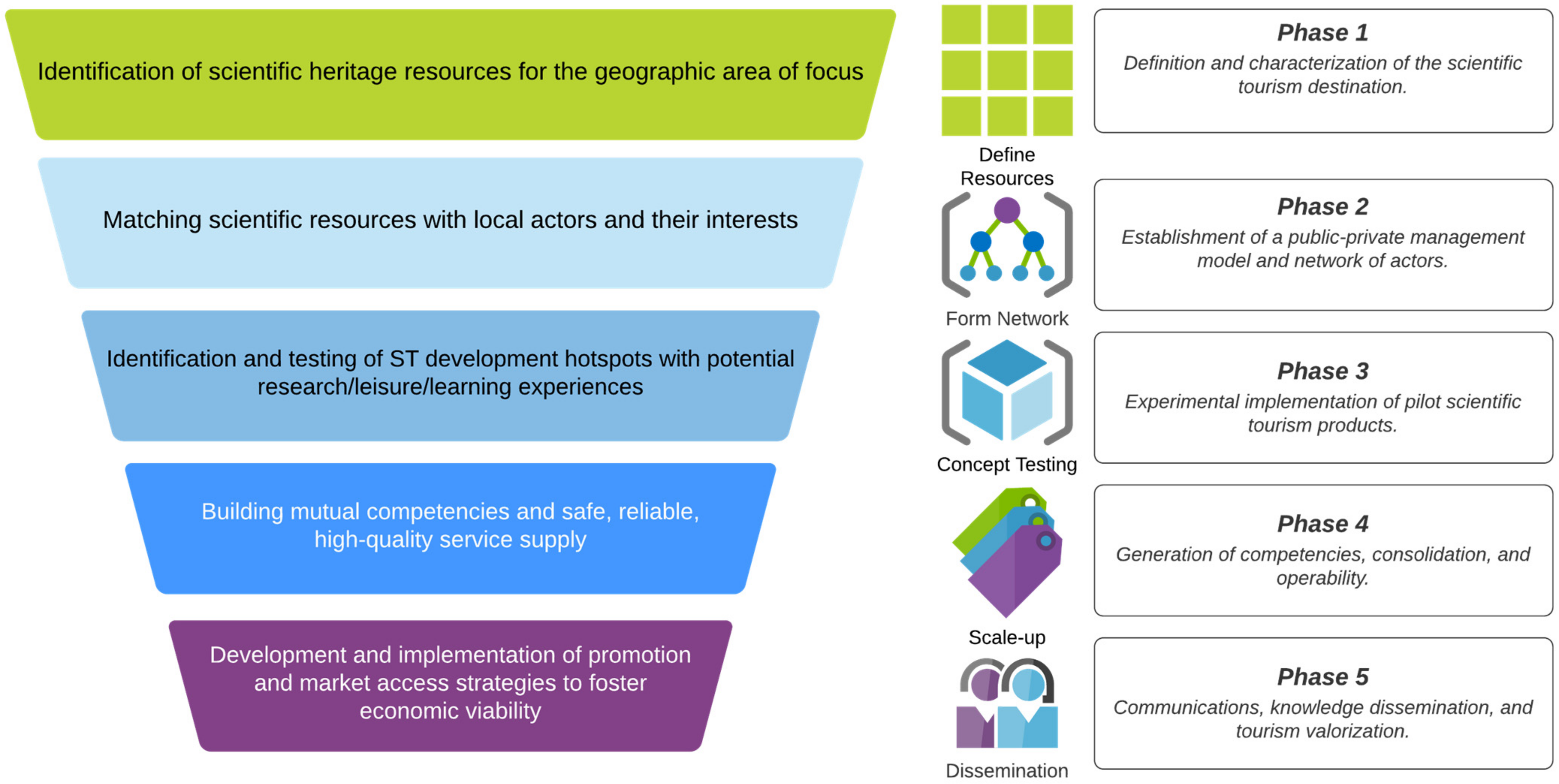
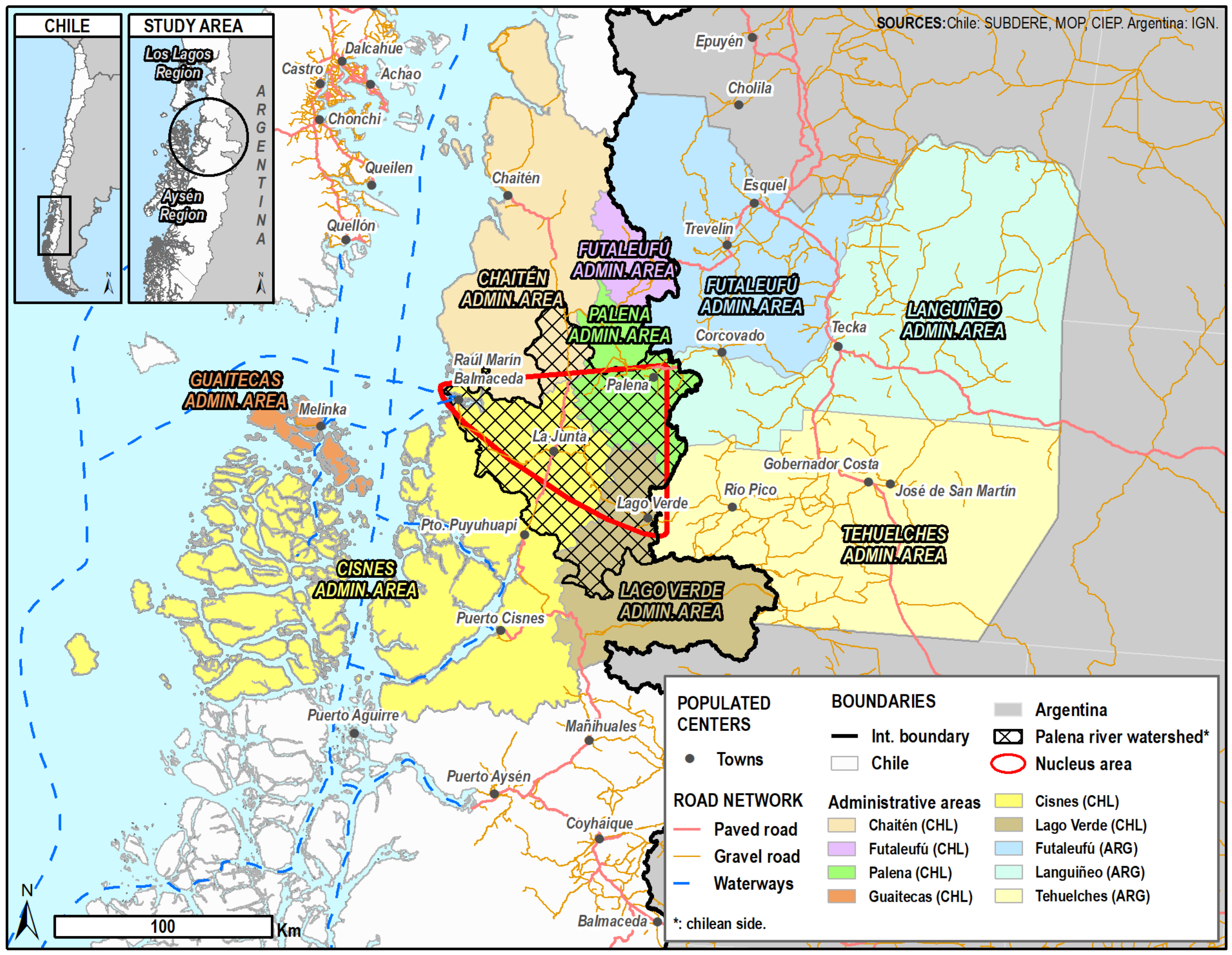
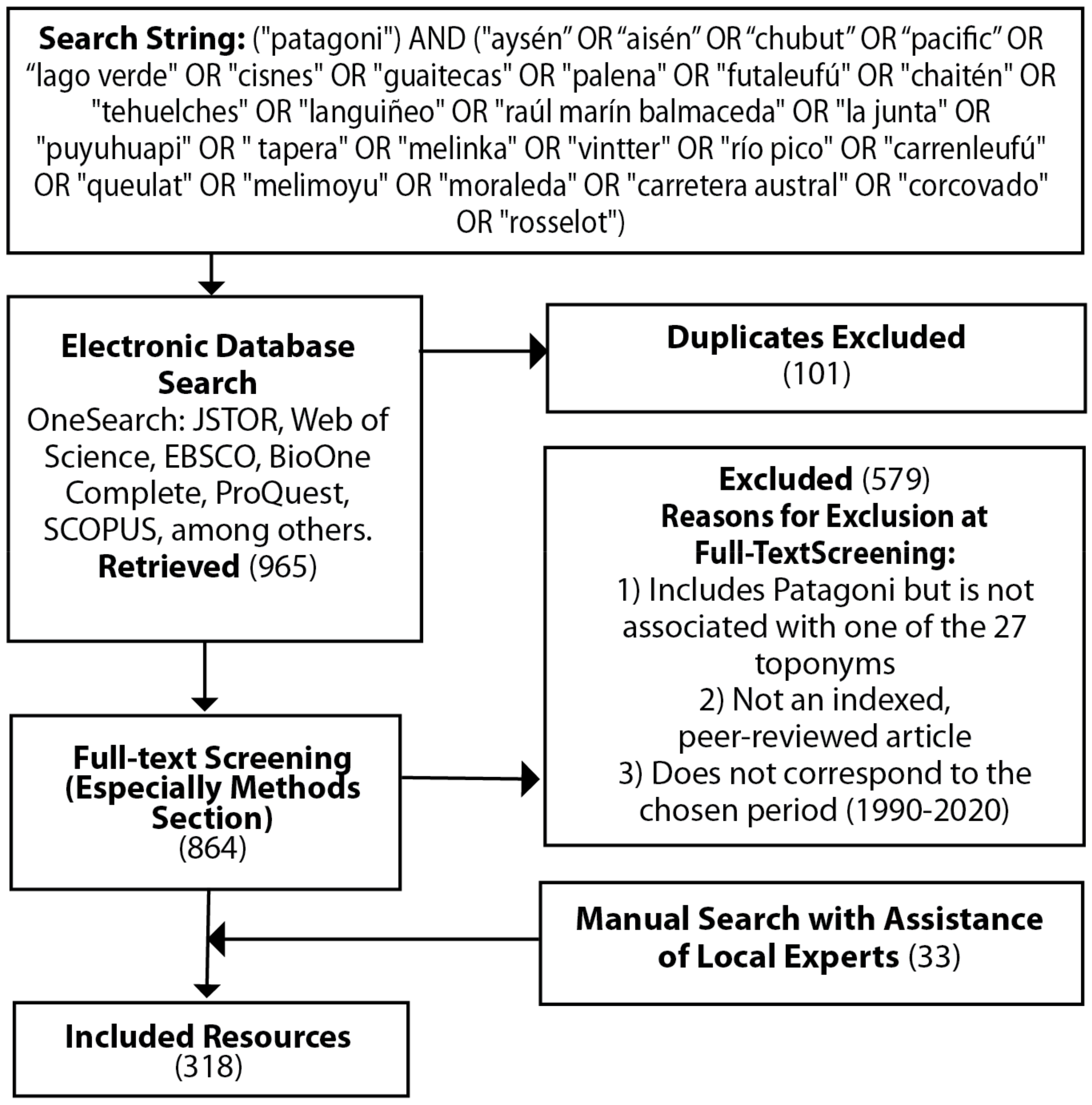
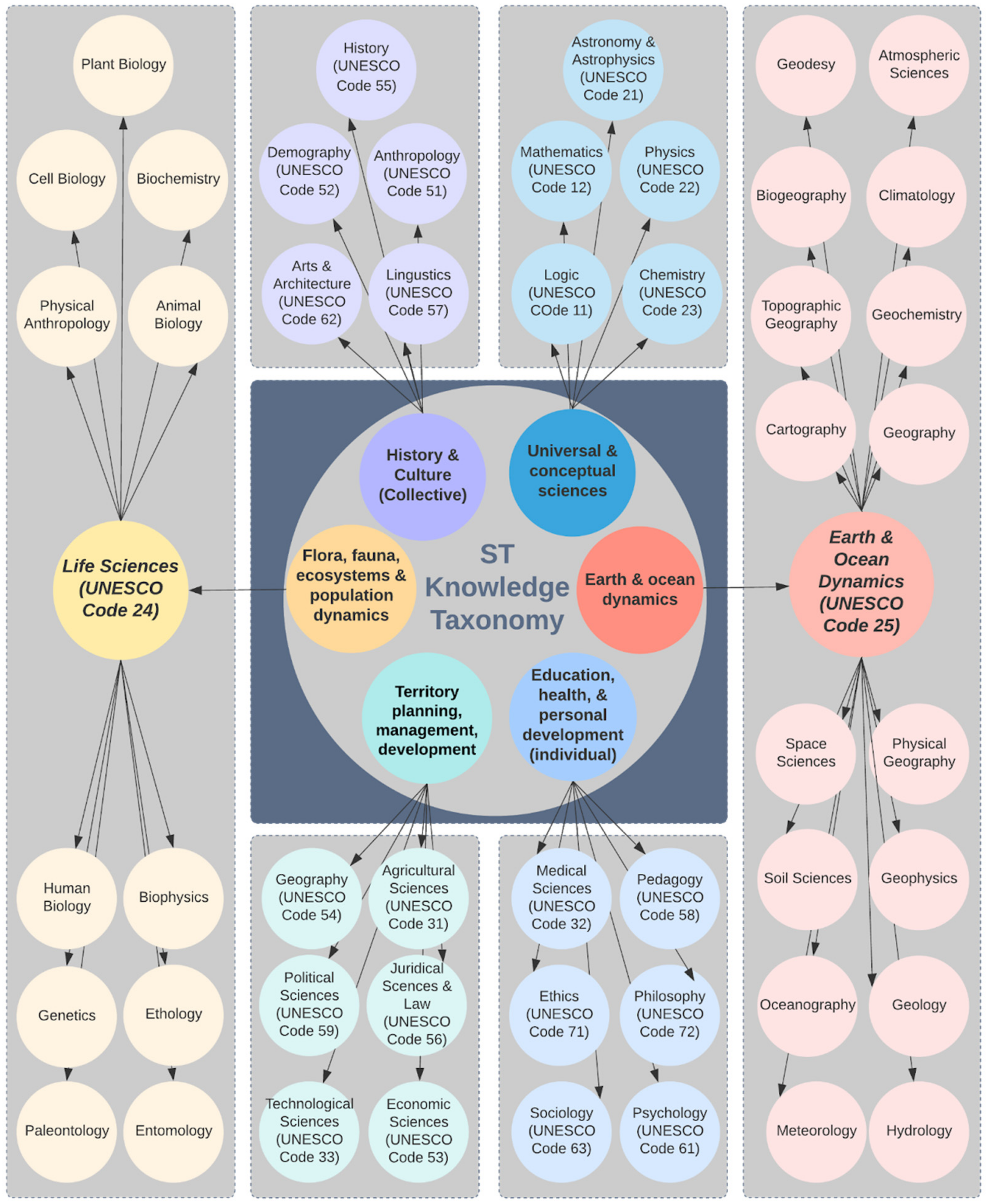
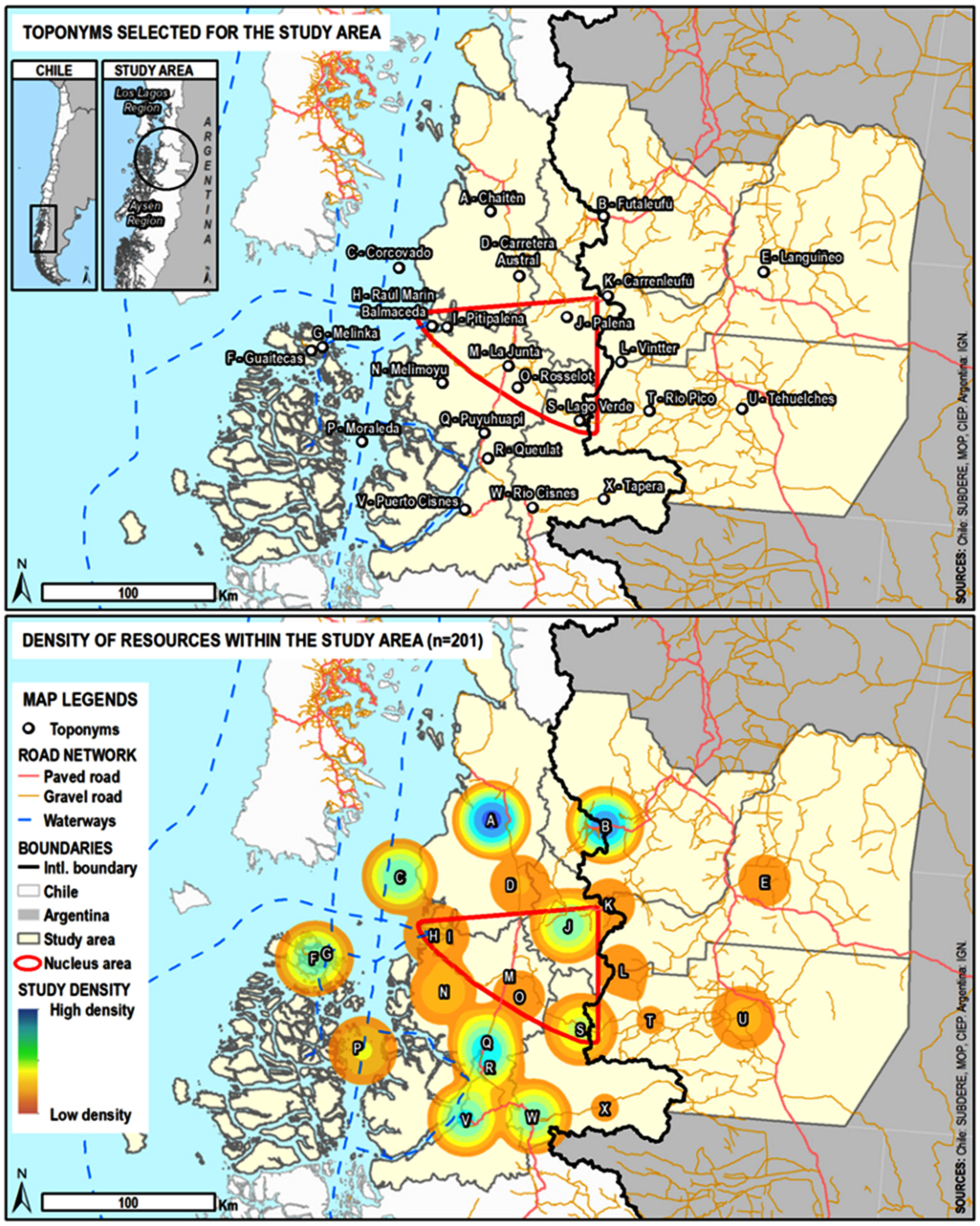
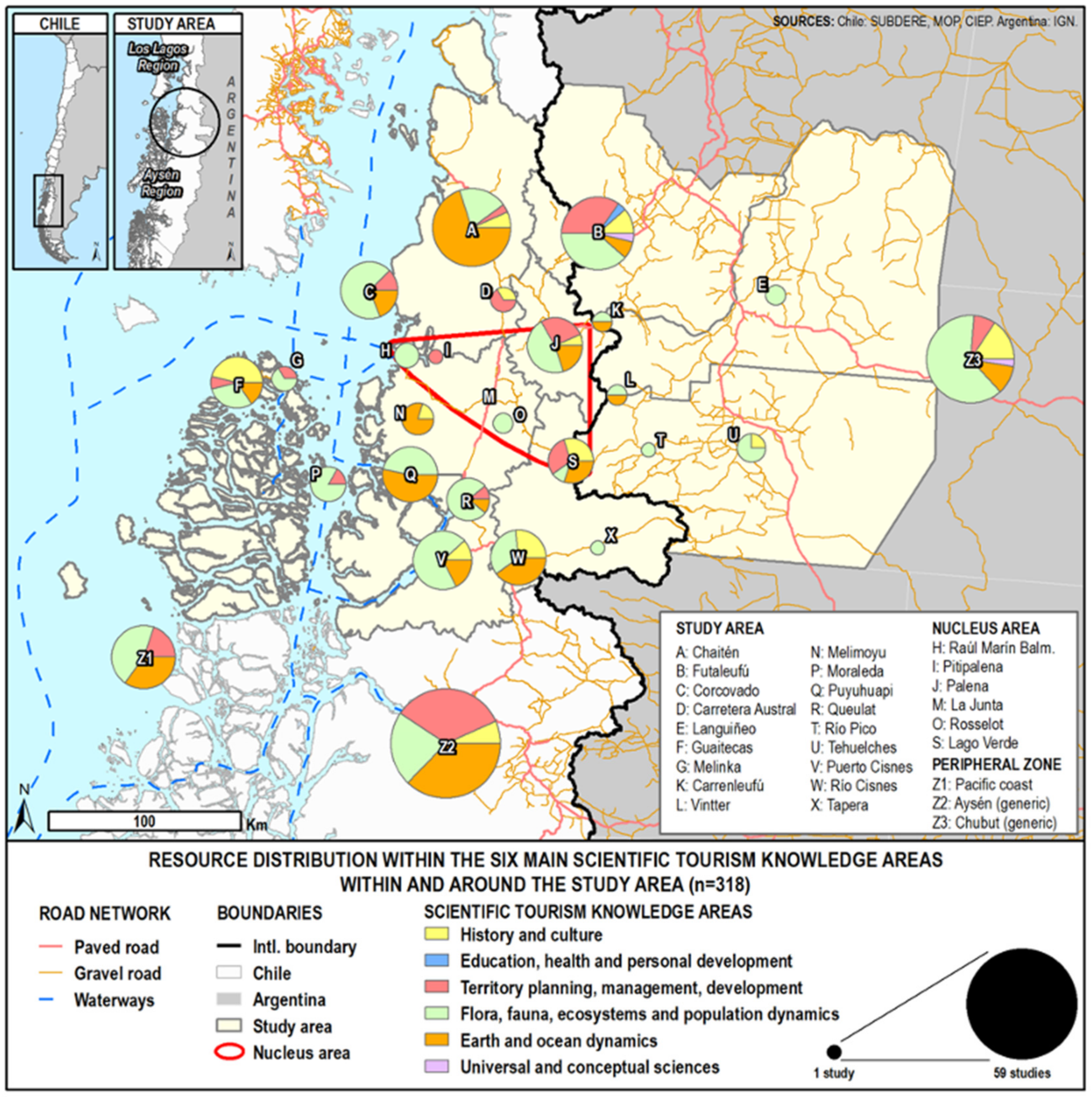
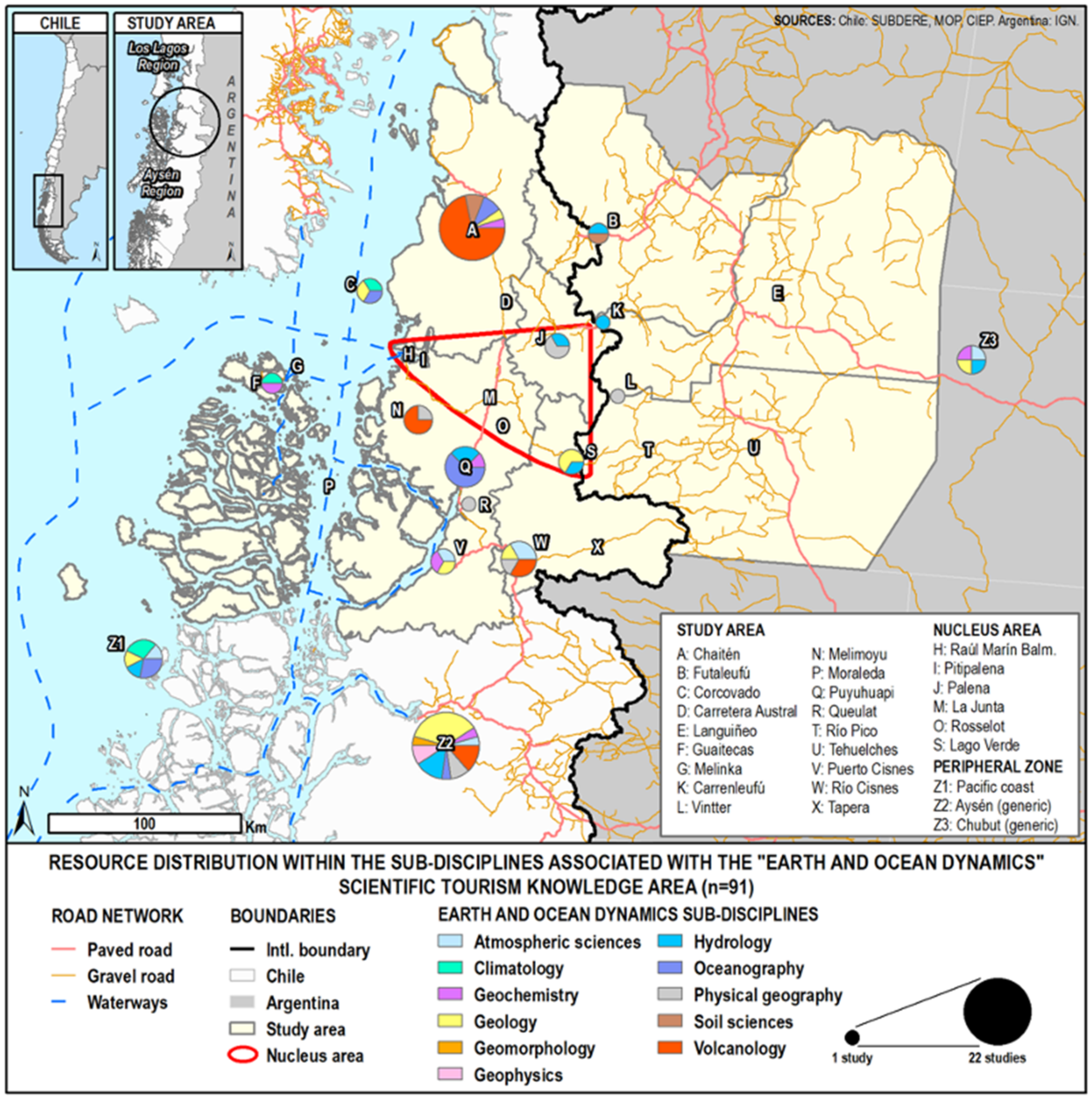
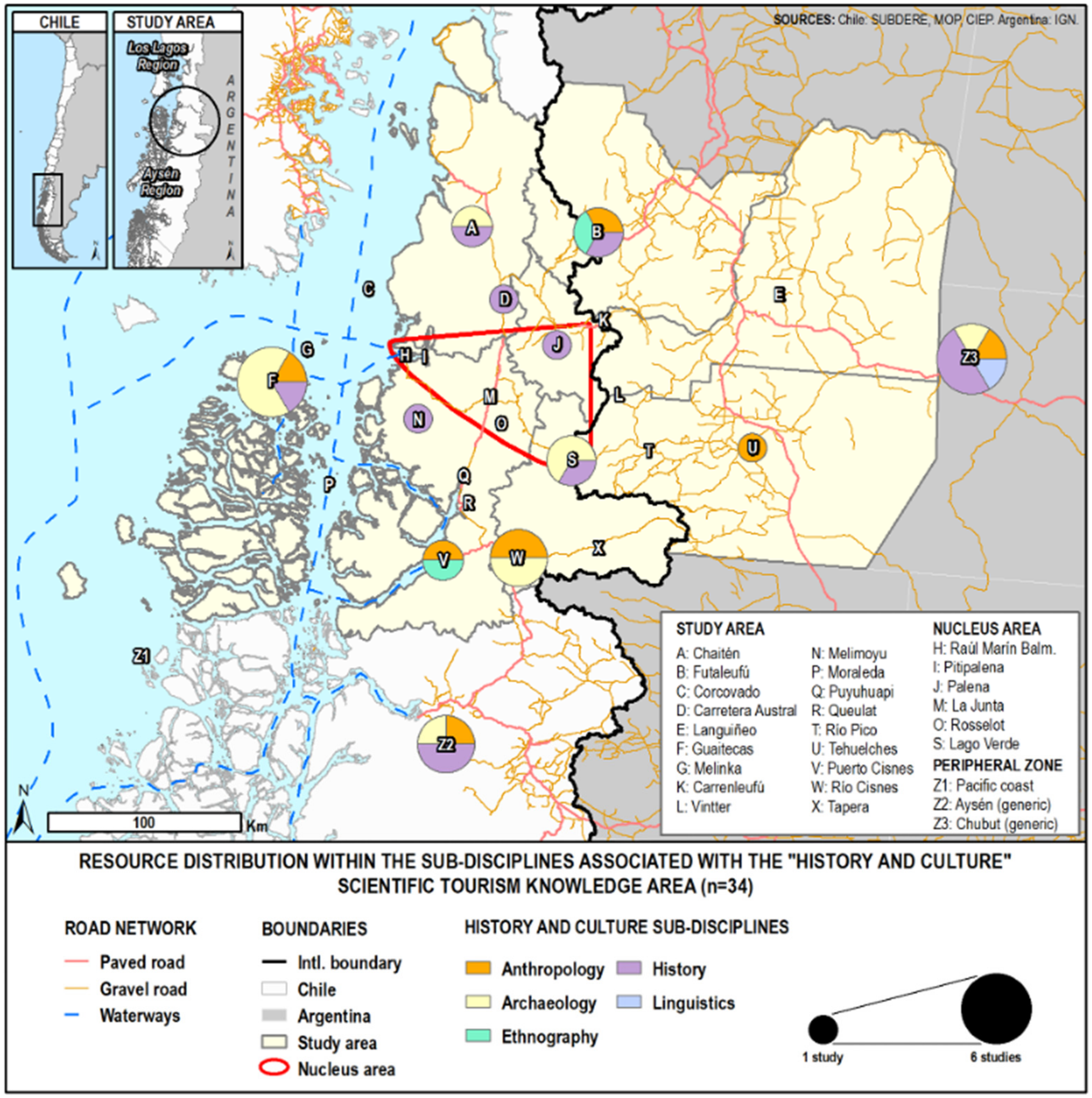
| Scientific Tourism Knowledge Areas | UNESCO 2013 Scientific Sub-Disciplines | Number of Resources |
|---|---|---|
| History and Culture | Anthropology, UNESCO code 51 (n = 10) | 33 |
| (Anthropology, n = 8; Ethnography, n = 2) | ||
| History, UNESCO code 55 (n = 22) | ||
| (History, n = 12; Archaeology, n = 11) | ||
| Demography, UNESCO code 52 (n = 0) | ||
| Sciences of Arts and Letters, UNESCO code 62 (n = 0) | ||
| Linguistics, UNESCO code 57 (n = 1) | ||
| Education, Health and Personal Development | Medical Sciences, UNESCO code 32 (n = 1) | 1 |
| (Epidemiology, n = 1) | ||
| Pedagogy, UNESCO code 58 (n = 0) | ||
| Psychology, UNESCO code 61 (n = 0) | ||
| Sociology, UNESCO code 63 (n = 0) | ||
| Ethics, UNESCO code 71 (n = 0) | ||
| Philosophy, UNESCO code 72 (n = 0) | ||
| Territory Planning, Management, and Development | Geography, UNESCO code 54 (n = 24) | 53 |
| Agricultural Sciences, UNESCO code 31 (n = 22) | ||
| (Agricultural Sciences, n = 1; Agronomy, n = 2; Forestry, n = 4; Animal husbandry, n = 1; Fish and wildlife, n = 14) | ||
| Technological Sciences, UNESCO code 33 (n = 1) | ||
| Economic Sciences, UNESCO code 53 (n = 4) | ||
| Juridical Sciences and Law, UNESCO code 56 (n = 0) | ||
| Political Sciences, UNESCO code 59 (n = 2) | ||
| Flora, Fauna, Ecosystems and Population Dynamics | Life Sciences, UNESCO code 24 (n = 137) | 137 |
| (Plant biology, n = 12; Cell Biology, n = 7; Animal biology, n = 27; Ethology, n = 10; Genetics, n = 43; Entomology, n = 5; Palaeontology, n = 10; Ecology, n = 23) | ||
| Earth and Ocean Dynamics | Earth and Space Sciences, UNESCO code 25 (n = 91) | 91 |
| (Atmospheric Sciences and Climatology, n = 6; Climatology, n = 4; Geochemistry, n = 6; Physical Geography, n = 8; Geology, n = 16; Volcanology, n = 23; Geomorphology, n = 1; Geophysics, n = 2; Hydrology, n = 11; Oceanography, n = 11; Soil Sciences, n = 3) | ||
| Universal and Conceptual Sciences | Logic, UNESCO code 11 (n = 0) | 2 |
| Mathematics, UNESCO code 12 (n = 0) | ||
| Astronomy and Astrophysics, UNESCO code 21 (n = 0) | ||
| Physics, UNESCO code 22 (n = 0) | ||
| Chemistry, UNESCO code 23 (n = 2) | ||
| TOTAL | 318 |
Publisher’s Note: MDPI stays neutral with regard to jurisdictional claims in published maps and institutional affiliations. |
© 2021 by the authors. Licensee MDPI, Basel, Switzerland. This article is an open access article distributed under the terms and conditions of the Creative Commons Attribution (CC BY) license (https://creativecommons.org/licenses/by/4.0/).
Share and Cite
Bourlon, F.; Gale, T.; Adiego, A.; Álvarez-Barra, V.; Salazar, A. Grounding Sustainable Tourism in Science—A Geographic Approach. Sustainability 2021, 13, 7455. https://doi.org/10.3390/su13137455
Bourlon F, Gale T, Adiego A, Álvarez-Barra V, Salazar A. Grounding Sustainable Tourism in Science—A Geographic Approach. Sustainability. 2021; 13(13):7455. https://doi.org/10.3390/su13137455
Chicago/Turabian StyleBourlon, Fabien, Trace Gale, Andrés Adiego, Valentina Álvarez-Barra, and Alexandra Salazar. 2021. "Grounding Sustainable Tourism in Science—A Geographic Approach" Sustainability 13, no. 13: 7455. https://doi.org/10.3390/su13137455
APA StyleBourlon, F., Gale, T., Adiego, A., Álvarez-Barra, V., & Salazar, A. (2021). Grounding Sustainable Tourism in Science—A Geographic Approach. Sustainability, 13(13), 7455. https://doi.org/10.3390/su13137455






